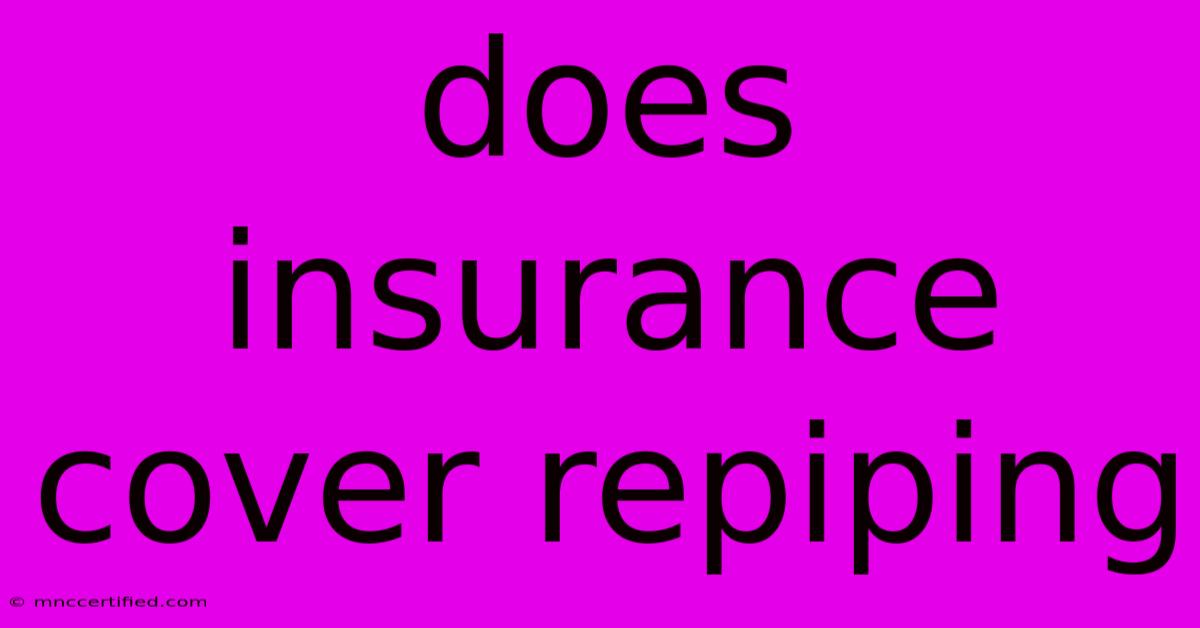Does Insurance Cover Repiping

Table of Contents
Does Insurance Cover Repiping? A Comprehensive Guide
Repiping your entire house is a significant undertaking, both financially and logistically. The question on many homeowners' minds is: Does my insurance cover repiping? The short answer is: it depends. There's no simple yes or no. This comprehensive guide will break down the factors that determine whether your insurance will cover repiping costs, helping you navigate this complex issue.
Understanding Your Home Insurance Policy
Before diving into specific scenarios, it's crucial to understand your home insurance policy inside and out. Your policy outlines what's covered and what isn't. Key sections to review include:
-
Perils Covered: This section lists the events your insurance covers, such as fire, wind damage, or burst pipes. Repiping is rarely covered directly as a stand-alone event. Insurance typically covers the damage caused by a covered peril, not the preventative measure of repiping itself.
-
Exclusions: This section explicitly states what your policy doesn't cover. Common exclusions include normal wear and tear, gradual deterioration, and preventative maintenance. Repiping due to aging pipes often falls under these exclusions.
-
Deductible: Remember your deductible. Even if your insurance covers part of the repiping, you'll likely have to pay your deductible upfront.
Scenarios Where Insurance Might Cover Repiping Costs
While repiping isn't usually a covered expense, there are circumstances where your insurance company might contribute:
1. Sudden and Accidental Damage from a Covered Peril
This is the most common scenario where insurance could potentially help with repiping costs. If a covered event, like a burst pipe due to a sudden freeze, causes widespread damage to your plumbing system, your insurance might cover the cost of repairs, which could include repiping sections of your home. The key here is the sudden and accidental nature of the damage. Gradual deterioration or corrosion is generally not covered.
2. Water Damage from a Covered Peril
Extensive water damage from a covered peril (e.g., fire suppression efforts, severe storm leading to flooding) can necessitate repiping. The insurance company might cover the cost of replacing damaged pipes as part of the overall water damage restoration. Again, it's the consequence of the covered event, not the repiping itself, that’s covered.
3. Faulty Workmanship (Within Policy Limits)
If the damage is due to faulty workmanship during a previous repair covered by your insurance policy, and this faulty work directly caused the need for repiping, you might have a claim. However, proving faulty workmanship often requires expert assessment.
Scenarios Where Insurance Will Not Cover Repiping
In most cases, the following situations will not result in insurance coverage for repiping:
- Normal Wear and Tear: Pipes aging and corroding over time are considered normal wear and tear and are not covered by insurance.
- Preventative Maintenance: Repiping to prevent future problems is considered preventative maintenance and is not a covered expense.
- Improper Installation (Original Installation): Issues stemming from the original installation of the pipes are generally not covered by home insurance unless a defect was present from the manufacturer.
- Lack of Maintenance: Failure to properly maintain your plumbing system, leading to extensive damage, may not be covered.
What to Do If You Need Repiping
If you need to repipe your home, here's what you should do:
- Review your policy thoroughly: Understand your coverage and exclusions.
- Document the damage: Take photos and videos of any damage to your plumbing system.
- Contact your insurance company immediately: File a claim and provide all necessary documentation.
- Get multiple quotes from reputable plumbers: Compare prices and services.
- Negotiate with your insurance company: If your claim is denied, understand the reasons and explore options for appealing the decision. Consider seeking legal counsel if necessary.
Conclusion
While home insurance might cover repiping in specific circumstances resulting from a covered peril and subsequent damage, it's not typically a covered expense for preventative maintenance or normal wear and tear. Understanding your policy, documenting damage thoroughly, and communicating effectively with your insurance company are crucial steps in navigating the repiping process and determining the extent of potential coverage. Always seek professional advice from a plumber and legal counsel if needed.

Thank you for visiting our website wich cover about Does Insurance Cover Repiping. We hope the information provided has been useful to you. Feel free to contact us if you have any questions or need further assistance. See you next time and dont miss to bookmark.
Featured Posts
-
Chelsea Lineup Vs Heidenheim Confirmed
Nov 29, 2024
-
East Lincoln Insurance Agency
Nov 29, 2024
-
Matos Nfl History Bid Double Threat
Nov 29, 2024
-
Renters Insurance Chula Vista
Nov 29, 2024
-
Ex Soldier Khalife Iran Spy Conviction
Nov 29, 2024